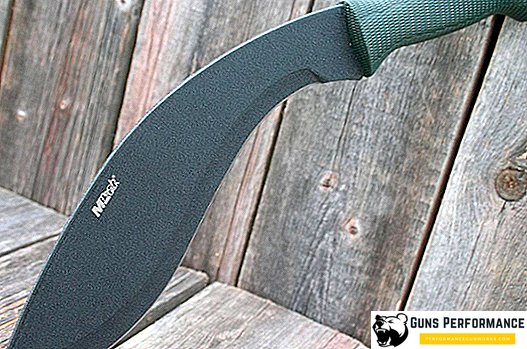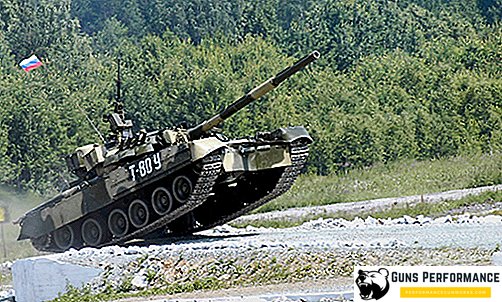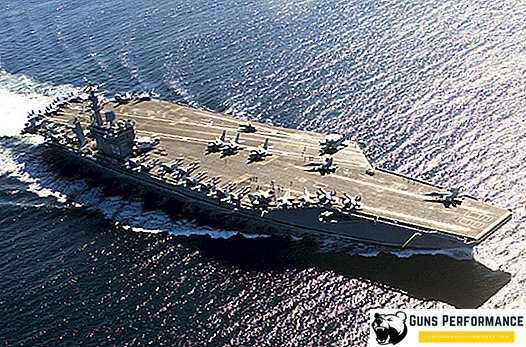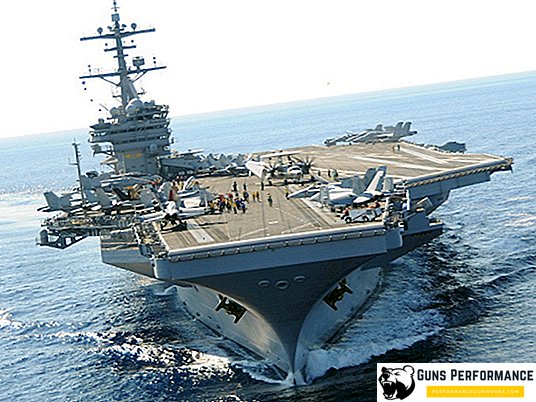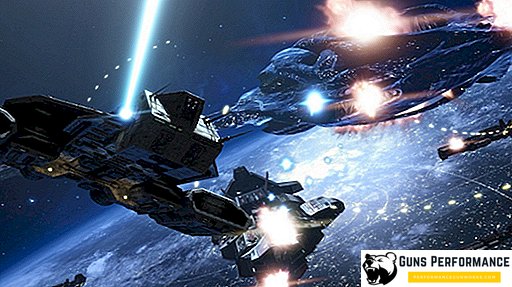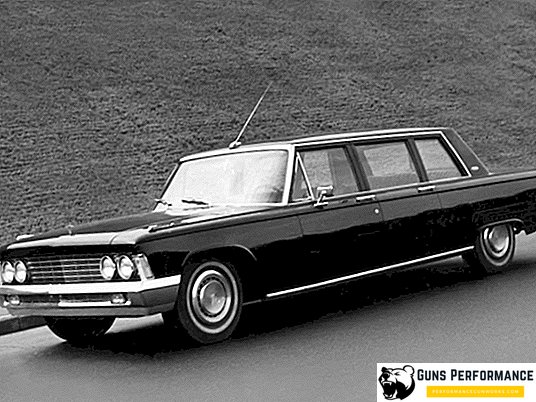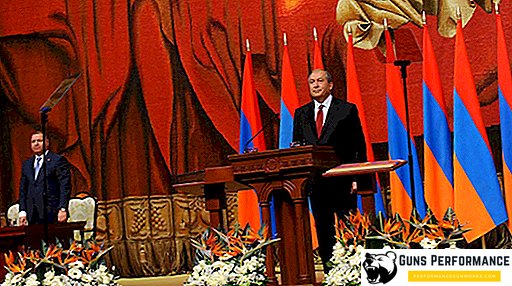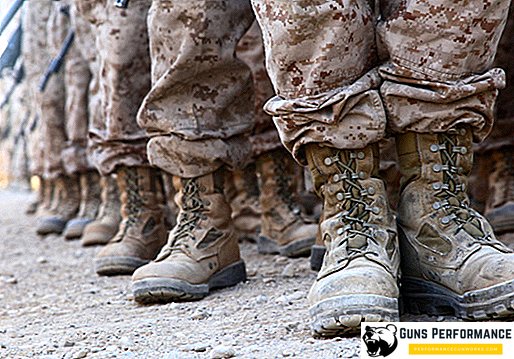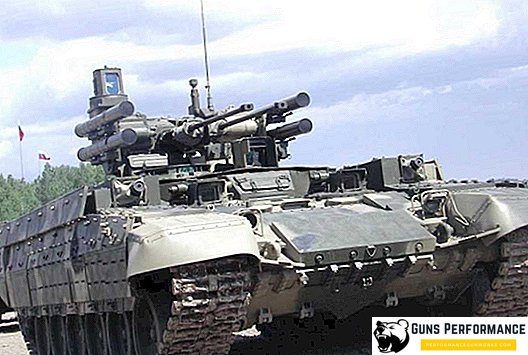
BMPT "Terminator" (Object 199 "Frame") is a Russian combat vehicle designed to directly support tanks on the battlefield. The main objective of BMPTs is the destruction of enemy anti-tank weapons (ATGM, manpower equipped with grenade launchers). The BMPT is also capable of effectively hitting enemy armored vehicles (tanks, infantry fighting vehicles, armored personnel carriers), long-term firing points and other targets with a high degree of protection. In fact, BMPT is a tank with small-caliber rapid-fire weapons installed on it.
"Terminator" - the unofficial name of the combat vehicle, invented by developers to attract foreign buyers. However, thanks to the journalists, it has already become popular and widely known.
The machine was developed by designers "Uralvagonzavod" (UVZ), the first sample was presented to the public in 2000. Since then, BMPT "Terminator" is a regular participant in all sorts of arms exhibitions and always attracts increased interest among potential customers. Despite this, the Terminator has not yet been adopted by the Russian army. Moreover, in 2010, the Ministry of Defense officially refused to purchase new BMPTs, although it still shows interest in this class of armored vehicles.
Currently, this combat vehicle is in service with the army of Kazakhstan: in the period from 2011 to 2013, ten units were delivered to the customer. There is information about the possible licensed production of BMPT in Kazakhstan. They wanted to launch it in 2018.
In 2013, in Nizhny Tagil, the premiere of a new tank support machine took place: the BMPT-72 or the Terminator-2, created on the basis of the main battle tank T-72. Later this car was presented at the exhibition of arms DEFEXPO-2014. The new machine is much more interesting to the Russian military than the first Terminator, although the BMPT-72 has not yet been adopted by the Russian army.
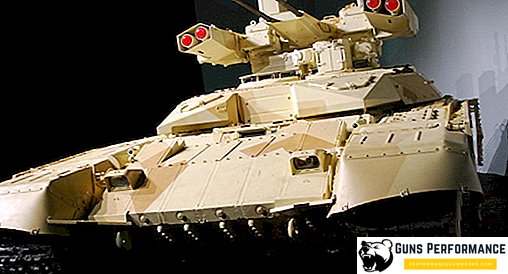
The history of the BMPT Terminator
Work on the creation of a machine to support tanks in battle began in the USSR back in the 80s. Apparently, Soviet strategists have drawn conclusions from the experience of using tanks in Afghanistan.
The fact is that these combat vehicles in conditions of modern combat are very vulnerable, especially in difficult conditions: in mountainous areas, in the forest or in urban areas. The main danger for armored vehicles is enemy infantry, armed with grenade launchers and anti-tank missile systems. These anti-tank weapons are very effective, they are very mobile, easily disguised and can suddenly open up powerful and accurate fire. An armored convoy, ambushed, can be destroyed in minutes. The armament of the tank is not very suitable for dealing with such threats - it is too powerful and not fast enough.
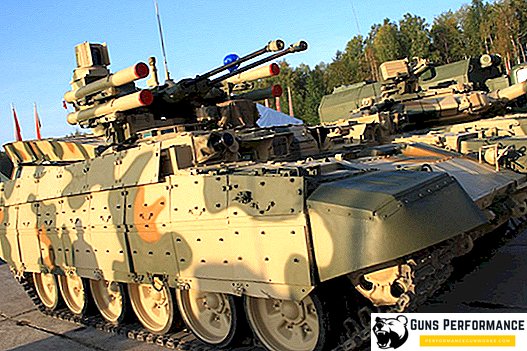
The Russian army has the tragic experience of using unprotected armored vehicles in urban environments. On January 1, 1995, during the storming of Grozny on the outskirts of the railway station of the Chechen capital, the 131st column of the Maikop brigade was almost completely destroyed. Within minutes, the separatist grenade launchers, entrenched in the buildings, burned more than 50 units of armored vehicles and vehicles.
In Afghanistan, Soviet forces often used the Shilka anti-aircraft installations to fight the enemy’s infantry. These chargers, which have an enormous rate of fire, can easily suppress any enemy firing point. The problem is that Shilka is designed to combat air targets and therefore has almost no armor protection. In addition, these installations do not have the necessary systems to detect the enemy on the ground.
The development of a tank support combat vehicle began in the mid-80s, but the creation of the Terminator began only in the late 90s at Uralvagonzavod. The first model of this BMPT, introduced in 2000, was armed with one 30-mm automatic cannon, a 7.62-mm machine gun coupled with it, four sets of Kornet anti-tank systems and two AGS course grenade launchers.
Later, the armament complex was changed: a second 30-mm cannon was installed on the combat vehicle, as well as the Attack guided weapon complex (AS). The basis for the BMPT was the chassis of the most modern tank of the Russian army - T-90.
The 30-mm cannon can hit lightly armored targets at distances of up to 1,500 meters, the Sturm anti-tank missile system can destroy enemy armored vehicles at a distance of 6 km, and two AGSs are designed to “strip” the enemy directly in front of BMPT. The fire control system allows the Terminator to simultaneously fire three targets.
According to the military, the firepower of one Terminator BMPT surpasses two motorized rifle platoons (six infantry fighting vehicles and forty personnel). The introduction of BMPT in the tank units will increase their efficiency by about a third.
However, despite these characteristics, the Russian military refused to buy this combat vehicle.
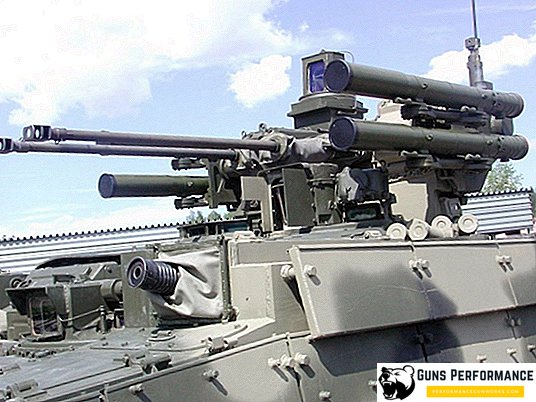
Design BMPT Terminator
BMPT "Terminator" was created on the basis of the T-90A tank and has the same level of armor protection. In addition, the machine uses dynamic protection "Relic", which significantly increases the survivability of BMPT even in conditions of massive use of anti-tank weapons.
Remotely controlled weapons module is located in the rear of the hull, ammunition is outside the fighting compartment, which significantly increases the chances of the crew in case of defeat BMPT cumulative ammunition.
The basic armament of the "Terminator" consists of:
- two automatic 30-mm cannons 2A42;
- 7.62-mm machine gun PKTM;
- ATRAK 9M120-1 ATGM with a laser guidance system (four launchers are located on the machine’s turret);
- Two automatic grenade launchers AGS-17 in fencing niches.
The crew of the "Terminator" consists of five people: a commander, a gunner, a driver and two gunners for course automatic grenade launchers.
At BMPT installed modern fire control system (FCS) "Frame". The gunner’s sight of the weapons module has an optical channel, a thermal imaging channel, an anti-tank guided missile laser guided control system, and a laser range finder. The commander of the vehicle has a panoramic sight with a 360 ° viewing sector. It has an optical and low-level television channel, as well as a laser range finder. If desired, the commander of the machine can display an image that the gunner sees on his screen. The OMS also includes a ballistic computer, a sensor system for determining the conditions of fire, and an automatic target tracking system.
The control of the weapons module is duplicated: if necessary, the commander can fire from all types of weapons located in the tower. Automatic course grenade launchers placed in fencing niches have a stabilization system in two planes, which allows for aimed fire during movement.
"Terminator" is equipped with a system for determining the exposure of the machine to a laser beam and automatic counteraction to this. When the laser irradiation triggers an audible alarm that warns the crew.
BMPT "Terminator" has a navigation system NAVSTAR / GLONASS.
The combat vehicle is equipped with a filter-ventilation unit, which pumps purified air into the fighting compartment, protecting the crew from the effects of toxic substances and radioactive dust. There is also an electromagnetic protection system designed for the premature detonation of mines and land mines equipped with radio-explosives.
The chassis of the BMPT is completely identical to the T-90; the B-92C2 diesel engine is installed on the Terminator.
As can be seen from the description, the Terminator BMPT is a truly formidable and well-armed vehicle, able to quickly detect an enemy and effectively destroy it. Why the Russian military did not want to take it into service? If they aren’t looking for good things, then why was the development of BMPT-72 needed?
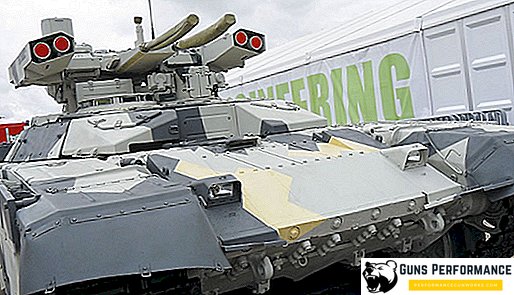
Design BMPT-72
The BMPT-72 (or Terminator-2) is designed to perform the same tasks as its predecessor: supporting tanks in battle and protecting them against mobile anti-tank weapons. The first "Terminator" caused a mixed reaction from the military, this car was seriously criticized. Among its shortcomings were both minor and easily fixable defects of the designers, as well as more significant issues.
The military was not satisfied with the complete lack of protection on the ATGM launchers, too many crew members, there were questions about the fire control system. However, the main problem was the cost of a new car. Using the chassis of the newest T-90 tank to create it made the Terminator’s price very high. In the case of the start of mass deliveries of new BMPT to the troops, the cost of it would be enormous. Therefore, the developers suggested a different way: to make BMPTs from outdated T-72 tanks, which allowed significant savings on the chassis of the new machine.
In addition, taking into account the operating experience of the first Terminator and the wishes of the military, other changes were made to the BMPT-72:
- Missile launchers of anti-tank missiles protected from bullets and shrapnel with armor covers
- The BMPT-72 removed AGS automatic course grenade launchers, which made it possible to reduce the crew by two people. These grenade launchers had a very limited firing angle and many blind spots. Thus, the crew of the BMPT-72 was brought in accordance with the standard states of the tank units
- Now, on the customer's request, both Russian and foreign communications and navigation systems can be installed.
- The fire control system was refined: now the commander of the vehicle received a panoramic sight with a full-fledged thermal imaging channel, similar to the one on the modernized T-90MS tank. This greatly increased the ability of the JMA.
- The outer contours of the housing BMPT-72 are made so as to minimize the level of the EPR machine
- The mass of "Terminator-2" decreased by three tons
- The BMPT-72 provides for the installation of a more powerful engine (up to 1000 hp).
In general, we can say that the “sequel” of the “Terminator” was easier, simpler and cheaper. However, this is not only the positive side. The elimination of two AGS grenade launchers from the armament complex of the vehicle significantly reduced its combat power: the BMPT-72 can fire only one target at a time, while the Terminator can fire three at a time. In addition, reducing the crew by two people worsened the view: after all, five pairs of eyes, watching the situation on the battlefield, are much better than three.
It should be noted that the appearance of the BMPT-72 is largely the merit of the Kazakh military, who are still the only operators of this type of military equipment. An agreement on the start of mass production of BMPT-72 in Kazakhstan was signed at the end of 2013 between Kazakhstan Engineering and the management of UVZ.

Project Evaluation
In general, the project of creating a specialized tank support machine can be assessed positively. In recent decades, the importance of tanks on the battlefield has steadily decreased, and their vulnerability, on the contrary, has grown. Especially defenseless tanks in the city.
The BMPT-72 will be able to more effectively accomplish combat missions in the conditions of urban development or difficult mountainous and wooded areas. This machine is lighter, it is more maneuverable than a tank, it has a smaller radius of overtoning (when turning the turret, the barrel practically does not go beyond the dimensions of the hull) and large vertical angles of pickup, which allows destroying targets from basements to upper floors of buildings.
In the case of joint actions with tanks, BMPTs can hit enemy light armored vehicles, their anti-tank weapons, and manpower. And fortifications and heavy armor of the enemy must be destroyed by tanks.
In addition, BMPTs can be used to support assault units, accompany the columns, that is, partially perform the functions of a heavy BMP.
Combat modules with rapid-fire guns and anti-tank systems can be installed not only on the T-72, but also on other outdated tanks, thus giving these combat vehicles a new life. Given the huge number of obsolete Soviet tanks stored in conservation, this is not only a relatively cheap way to increase the combat capability of the ground forces, but also an excellent opportunity to earn money in export markets.
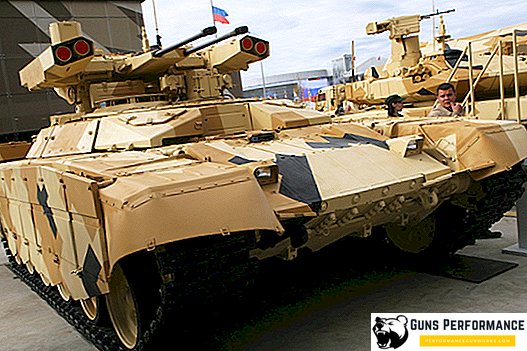
Perspectives: BMPT "Terminator-3"
Despite all the improvements, the BMPT-72, like the Terminator, was never adopted by the Russian army. In the USA, these two cars are considered an analogue of the BM2 M2 Bradley, with firepower and guidance and target designation at the level of the M2A2 modification. At least in the American troops, the BMD Bradley often performs similar tasks.
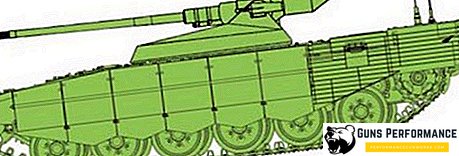
Recently, however, information has appeared on the development of a new Russian machine, which is unofficially called the "Terminator-3". They plan to carry it out on the basis of the Armata universal platform and equip it with the latest combat module AU-220M. He is the main "highlight" of the new machine. It includes a 57-mm cannon, which was developed for light combat ships. The gun has a rate of 300 rounds per minute and can hit targets at a distance of up to 12 km. That is, the new BMPT will be able to destroy all types of air and ground targets, even without entering into the zone of their return fire.
The 57-mm gun of the module pierces the 100-mm armor at a distance of four kilometers, and the usual panel building is pierced through at a distance of 4.5 km. Probably, this module will be equipped with anti-tank missile launchers, but there is no specific information about them yet. Based on the well-known characteristics of the combat module, we can say that the Terminator-3 will be able to effectively cover infantry and tanks at distances 1.5-2 times the effective range of the BMD Bradley and the BTR Stryker.
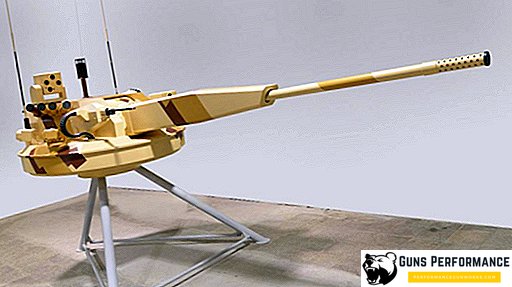
At what stage is the work on the creation of a new BMPT is unknown. However, in this case it becomes clear why the first and second modifications of the Terminator are not accepted for service. True, financial difficulties may arise: if the Terminator-1 was on the T-90 chassis for the Russian budget, would it pull the car on the base of “Almaty”?



